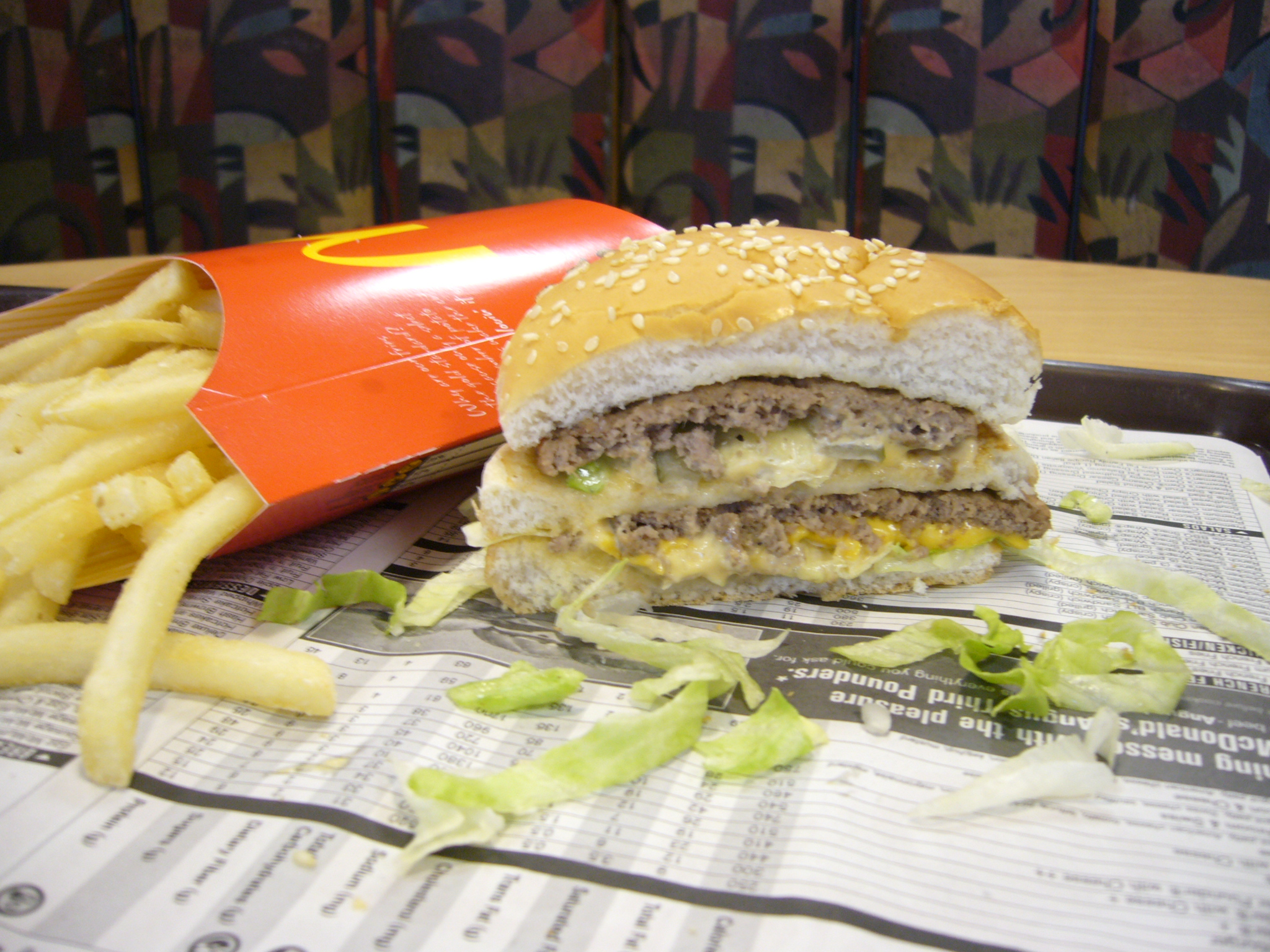BIG MAC

(Visit the Bigmac Museum)
Edible sign. 1. A hand-held
consumer product with chemical emanations that appeal
to the senses of smell and taste. 2. A portable, fast-food
symbol of the American way of life. 3. A mass-produced beef
sandwich whose stratified layers mark an incredibly long prehistory in time.
Usage: The Big Mac "speaks" with a simple eloquence millions
appreciate but few understand. Its meaty
taste is enhanced by the rush of primary salty,
sour, and sweet ingredients which address tongue receptors
directly, but have little effect on more discerning nerves of the nose.
Prehistory. The Big Mac encodes a potpourri of flavor messages from
the distant past. Because many of the sandwich's aroma and taste
cues precede written history, The Nonverbal Dictionary
excavated a Big Mac to decipher its chemical signs:
Layer I: Top bun. Harmonious flavor molecules released in cooking
have made bread and meat an age-old combination. The first oven-cooked bread,
invented by the Greeks, was eaten with opson (i.e., "non-bread"
vegetables and meats) on top; the open-faced sandwich later evolved as pizza.
(N.B.: According to a 2001 Parade magazine survey,
conducted in the U.S., pizza is the favorite takeout meal and number-one food
Americans say they "could not live without" [Hales 2001].) From the Dark Ages to
the Renaissance, thick bread slices (or trenchers) were prepared with
meat and sauce on top, paving the way for double-decker sandwiches,
such as the Big Mac.
Layer I: Seeds. Sesame seeds on top had earlier spread from the Nile
to the Orient, where they were mixed with wheat flour by pastry chefs for
centuries. Roasted seeds add a nutty flavor, which appeals to the
primate palate. Seeds provide tactile enjoyment for the tongue, as well (in
reptiles the tongue evolved as a sensory organ for touch; see EXISTENTIAL
CRUNCH).
Layers II & VIII: Meat. The browning reaction of cooked
beef releases furans, pyrones, and other carbon, hydrogen, and
oxygen molecules which provide the complex oniony, chocolaty, nutty, fruity, and
caramel-like tastes we prefer to the bland taste of uncooked flesh (McGee 1990).
At the heart of a Big Mac are two ground-beef patties, whose cooked flavor
compounds would have been familiar to Homo erectus in Africa 1.6
m.y.a.
Layer III: Pickle horizon. Gherkins, eaten in India with
salt or lemon juice for 3,000 years, came to Europe during the Renaissance.
Along with their crunchy texture, pickles add a primary sour taste
which has been enjoyed with lettuce since the Roman era.
Layers IV & X: Lettuce. A Big Mac contains 1/4 cup of chopped
head-lettuce (Lactuca sativa), a plant preferred by the ancient Greeks
above all other greens. Wild lettuce was prized for the soothing properties of
its magnesium content, as an aid to digestion. Because of a burger's high fat
content, our enteric nervous system considers lettuce a welcome
ingredient today.
Layers V & XI: Onions. One-half teaspoon of finely diced
onion, a root bulb, appears in each of two strata. An onion's volatile
sulphur compounds evolved as warning messages to deter hungry grubs and insects
(see SECONDARY PRODUCTS). Wild onions were used 4,000 years
ago by Egyptian peasants to season bland meals, and Egyptian mummies sometimes
included onions, wrapped in separate bandages, as carry-out for the
afterlife.
Layers VI & XII: Sauce. Sauce adds moisture, required for the
tongue to taste chemicals in solution. Sweet and sour sauces have flavored meats
for thousands of years, and the Big Mac uses a variant of thousand-island
dressing (made from salad oil, orange and lemon juice, minced onion,
paprika, Worcestershire sauce (a spicy Indian recipe), dry mustard, parsley, and
salt). The nonverbal secret of a Big Mac is the riddle of its sauce.
Layer IX: Cheese. A layer of American cheese lies above the
lettuce horizon. Cuneiform tablets place cheese in the Near East by ca. 6,000
years ago. Nature traces the origin of cheese to 7,000 years ago in northern Europe. According to Analytical Chemistry, the oldest actual cheese yet discovered is a 3,200-year-old jug of cheese from the ancient Egyptian city of Memphis. Cheese sends salty signals to the tongue tip, and its smoothness
blends well with the coarser texture of beef. Flavorful fatty acids and esters
of glycerol in cheese satisfy a natural craving for fat.
Neuro-notes. While the subtlety of cabernet, truffles, and haute
cuisine is processed by higher brain centers, capable of culinary learning, the
primary tastes of fast food are handled subcortically a. in the
thalamus, and b. in a buried part of the cerebral
cortex called the insula (which is emotionally linked to the amygdala and limbic
system). Like primary colors, the basic bitter,
salty, sour, and sweet tastes of fast-food
coffee, fries, pickles, and soda make brash
rather than subtle statements.
See also COCA-COLA.
YouTube Video: How to Make a Big Mac (U.S. version)
Copyright 1998 - 2018 (David B. Givens/Center for Nonverbal Studies)
Photo of a sliced Big Mac (December 19, 2009, 2:00 PM, at McDonald's, 2903 E. 29th Avenue, Spokane, Wash., 99223, USA [cut through with a plastic serrated knife provided by the restaurant]) by Doreen K. Givens (copyright 2009)